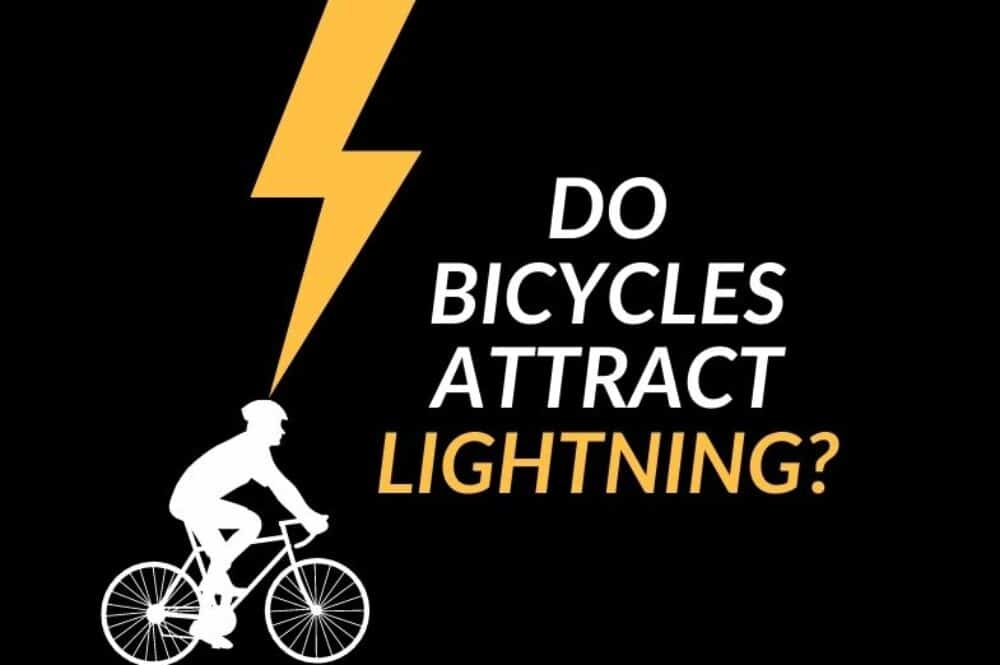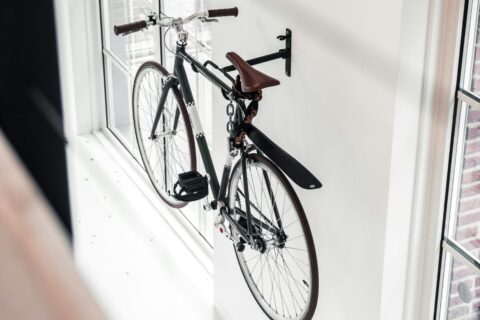This post may contain affiliate links, which help to keep Discerning Cyclist rolling. Learn more.
Every year, the UK and Ireland typically experiences between 200,000 and 300,000 lightning counts, with 10,000 per day quite normal during a particularly bad storm.
But despite being a relatively common weather phenomenon, there are plenty of myths surrounding lightning. The phrase “lightning never strikes the same place twice” is in fact a myth, as is the idea that getting down as low as possible can offer you complete protection.
Not knowing what to do in a lightning storm could potentially be life-threatening. But you also can’t always predict extreme weather and avoid it, especially as a previous survey by Discerning Cyclist showed that not even heavy rain is likely to put off a lot of riders.
So, do bikes attract lightning, and what is your risk level if you are outside on a bicycle when thunder and lightning starts?

1. What “Attracts” Lightning?
The height of an object, whether it is a pointy shape, and how isolated it is are the dominant factors controlling where a lightning bolt will hit. Mountains, for example, are a common target, as are lone trees and telegraph poles.
This is because the current will often seek the easiest route to ground, so targeting taller or solitary objects means it has less distance to travel. However, there is no guarantee that they will take preference—lightning is indiscriminate and often unpredictable.
Many people believe that anything metallic is a likely target for a lightning bolt to come into contact with. However, the presence of metal actually has little effect on where lightning will strike.
While metal has no effect on where lightning will strike, it does still act as a conductor, so if a metallic object (such as a bike) is struck, the lightning will most definitely make contact with the ground and cause damage to the object and anything it is in contact with. This is why it is dangerous to be in contact with metal if it is struck.
2. Do Bikes Attract Lightning?
Given this information, a bicycle will not specifically attract lightning or be any more of a target than a tree, telegraph pole or other object in the vicinity, but it is most certainly not safe just because something taller or larger is nearby.
As lightning is more likely to hit a higher point to seek the easiest route to the ground, you are at more risk if you’re cycling on a hill or mountain. If you are in a very sparse, open and flat area with not much else around, there may be an increased risk that your bike will be a target too.
Due to lightning being so unpredictable, as soon as a storm with thunder begins, action should be taken to keep yourself as safe as possible.
3. Has a Cyclist Ever Been Struck by Lightning?
Unfortunately, cyclists have been struck by lightning on occasion, but there isn’t necessarily proof that it was because they were on a bike, and indeed, many instances have actually occurred when the cyclist has taken shelter.
Anybody outdoors during a thunderstorm can potentially be struck, with casualties much higher during the summer months when outdoor activities are on the rise (and people are more likely to be outdoors cycling).
Three siblings in Maidenhead were struck when sheltering from a storm under a tree in 2021, for example. There are plenty of stories of near-misses too. The samy year, a trio of cyclists narrowly avoided being struck by lightning when riding down an outback street in Australia, with dashcam footage from a fellow oncoming cyclist showing just how close they were to being hit.
4. How Many Cyclists Have Been Killed by Lightning?
To date, there isn’t any specific data to tell us exactly how many cyclists have been killed by lightning. There was one reported incident back in 2018 when a 27-year-old German national was killed in Turkey after being struck by a lightning bolt while on his bike, and could not be saved despite being taken to a local hospital.
Others have been killed by lightning while on a cycling trip, however many took shelter so the bike was not a specific cause.
The clearest indication of potential numbers was a 2020 study from the United States, showing that from 2006 through 2019, 418 people were struck and killed by lightning there, and two-thirds of those had been enjoying outdoor pursuits. In fact, those riding bikes, motorcycles and ATVs accounted for 7% of the deaths.
5. Are Bikes Safe in Lightning?
While it may be unlikely they will be the specific target versus a taller, larger object, there is no guarantee that bikes won’t be struck by lightning. In fact, when there is a thunderstorm, nothing in the area is ‘safe’ from a potential lightning bolt and it is certainly not worth taking risks.
Because the metal on a bike is a conductor, if it were to be struck, anything in contact with the bike would be burnt (and this could prove fatal to humans). It is yet another myth that the tyres of a bike will protect you, too. There is simply not enough rubber present to make a difference, even though the material itself is a good electrical insulator.
6. Is It Safe to Cycle in Lighting?
No. You should immediately stop, get off your bike and seek shelter if you feel there is a risk of getting struck by lightning, or even if you just hear thunder, rather than carrying on. Leave your bike where it is—do not keep contact with it.
Even if lightning seems far away, it can strike close by. Lightning is not necessarily the only risk in a storm either, with rain and high winds being potentially dangerous in themselves.
So, as soon as a storm begins, you should start acting. If thunder is then heard, this is when to immediately begin protecting yourself from the inevitable lightning.
What else should you do if you’re cycling in a lightning storm? As well as getting off the bike, try to find a lower point to shelter, and get off elevated points such as hills and mountains. Never continue to go higher.
Crouching can reduce the risk of you being targeted but does not eliminate you from danger completely, and lying flat on the ground must be avoided as you can be affected by the ground current.
Don’t use trees or cliffs for shelter, and get away from water. If you are wet from rain, try to put something dry over you to keep warm. It is recommended that cyclists always take a dry packable coat with them that can be worn in this particular eventuality. Stay away from metal poles, fences and other objects, too.
If you are cycling in a group, move away from one another. There are stories of people ‘huddling’ for comfort in a storm and then being struck—you’re less likely to be a target if you’re alone, and it means others can go for help if somebody is injured.
Once the storm has passed, it is also recommended that you wait for 30 minutes to ensure the harmful electrical build-up has died down.
Ideally, find shelter in a completely enclosed building or car, or an underpass which hasn’t flooded. If this isn’t possible, following the above tips until the storm has passed should hopefully mean you stay safe.










